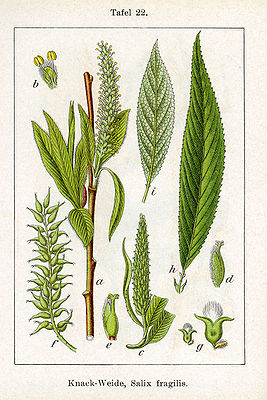Broken Willow
| Broken Willow | ||||||||||||
|---|---|---|---|---|---|---|---|---|---|---|---|---|

Broken willow ( Salix fragilis ), illustration |
||||||||||||
| Systematics | ||||||||||||
|
||||||||||||
| Scientific name | ||||||||||||
| Salix fragilis | ||||||||||||
| L. |
The crack willow ( Salix fragilis ), even cracking pasture called, is a plant of the genus of willows . This species owes its German and botanical names to its thin branches, which break easily at the base with a smooth break and audible cracking. These are often torn off by floods and then re-root when they are washed up on the bank elsewhere.
description
The Bruch-Willow is a tree that reaches heights of up to 15 m and already has a broad, arched crown in its youth. The dark gray bark is initially scaly, later deeply furrowed. Before the leaves and inflorescences appear, the twigs turn more and more rust-brown in spring. The elongated, pointed leaves reach a length of 12 centimeters. Its edge is finely serrated, the top is shiny, light green, the underside pale gray and bluish with frost. The petiole is 1–2 centimeters long, at the transition to the leaf base there are two small glandular bumps . The flowers of the Bruch willow develop as catkins from March to April ; the males become 2–5 centimeters long and are yellow in color, the greenish females reach a length of 10 centimeters. The fruits of the tree are seed-containing capsules with woolly hairs that ripen from May to June.
The number of chromosomes is 2n = 76 or 114.
Location
The broken willow originally comes from Eastern Europe and Russia ; however, it has now spread to the rest of the continent. In the Alps it rarely rises above 1000 m, in southern Europe sometimes up to 1900 m. The Bruch willow primarily grows along streams. There are often clusters of crack willows of the same sex here, created after the broken branches of a fallen tree or broken branches took root. It is also often planted as a park tree near water or as a bank reinforcement. The broken willow prefers oozing wet, at times flooded, nutrient-rich, base-rich but mostly lime-poor gravel, sand or loam soils. It is a character species of Salicetum fragilis from the Salicion albae association, but also occurs in the Stellario-Alnetum of the Alno-Ulmion association.
Systematics
Between Salix fragilis and the white willow ( Salix alba ) - which was the tree of the year in 1999 - bastard formations easily occur , which then results in the pale willow ( Salix × rubens cupboard ). All three types can easily be confused with one another.
The following hybrids are known:
- Foxtail willow ( Salix × alopecuroides exchange ): Salix triandra ( almond willow ) × Salix fragilis
- Salix × margaretea O. V. Seeman : Salix purpurea ( purple willow ) × Salix fragilis
- Fragile Laurel Willow ( Salix × meyeriana Rostkov ex Willd. ): Salix pentandra ( Laurel Willow ) × Salix fragilis
- Salix × pendulina Wenderoth : Salix babylonica ( real weeping willow ) × Salix fragilis
- Pale willow ( Salix × rubens cupboard ): Salix alba ( silver willow ) × Salix fragilis
ecology
The Bruch-Willow is a soil strengthener with intensive roots.
use
The soft, light wood of the Bruch-Willow is u. a. used to make prostheses and wooden shoes .
literature
- Georg Zauner: GU-Kompass Deciduous trees: the important tree species - getting to know and determining made easy. Gräfe and Unzer, Munich 1990, ISBN 3-7742-6205-5 , p. 22f.
Individual evidence
- ↑ a b c Erich Oberdorfer : Plant-sociological excursion flora for Germany and neighboring areas . 8th edition. Verlag Eugen Ulmer, Stuttgart 2001, ISBN 3-8001-3131-5 . Page 305.
- ↑ Manfred A. Fischer , Wolfgang Adler, Karl Oswald (arrangement): Exkursionsflora for Austria, Liechtenstein and South Tyrol . 2nd Edition. Upper Austrian State Museums, Linz 2005, ISBN 3-85474-140-5 , p. 439 (" collin - untermontan "). - Adolf Polatschek: Flora from North Tyrol, East Tyrol and Vorarlberg . tape 4 . Tiroler Landesmuseum Ferdinandeum, Innsbruck 2001, p. 87 (highest indication of the place where it was found “1000–1120 m”, otherwise mostly in the valley area up to approx. 700 m). - Konrad Lauber, Gerhart Wagner: Flora Helvetica . 4th edition. Haupt-Verlag, Bern / Stuttgart / Vienna 2007, ISBN 978-3-258-07205-0 , p. 328 (" kollin (- montan) ").
- ^ Giancarlo Marconi, Francesco Corbetta: Flora della Pianura Padana e dell'Appennino Settentrionale. Photo atlante della flora vascolare . Zanichelli editore, Bologna 2013, ISBN 978-88-08-06291-8 , p. 27 (Italian, "0-1000 m"). - Jean-Marc Tison, Bruno de Foucault, Société botanique de France: Flora Gallica. Flore de France . 1st edition, 2nd printing (with numerous corrections). Biotope Éditions, Mèze 2014, ISBN 978-2-36662-012-2 , p. 1033 (French, "0–1800 m"). - Santiago Castroviejo (ed.): Flora iberica. Plantas vasculares de la Península Ibérica e Islas Baleares . tape 3 . Real Jardín Botánico, CSIC, Madrid 2005, p. 489 (Spanish, "0–1900 m"). - I. Aizpuru, C. Aseginolaza, PM Uribe-Echebarría, P. Urrutia, I. Zorrakin: Claves ilustradas de la flora del País Vasco y territorios limítrofes . 1st edition. Servicio Central de Publicaciones del Gobierno Vasco, Vitoria-Gasteiz 1999, ISBN 84-457-1396-5 , p. 191 (Spanish, "0–800 m").
Web links
- Broken Willow. In: FloraWeb.de.
- Broken Willow . In: BiolFlor, the database of biological-ecological characteristics of the flora of Germany.
- Profile and distribution map for Bavaria . In: Botanical Information Hub of Bavaria .
- Salix fragilis L. In: Info Flora , the national data and information center for Swiss flora . Retrieved October 2, 2015.
- Distribution in the northern hemisphere according to: Eric Hultén , Magnus Fries: Atlas of North European vascular plants 1986, ISBN 3-87429-263-0
- Thomas Meyer: Data sheet with identification key and photos at Flora-de: Flora von Deutschland (old name of the website: Flowers in Swabia )

